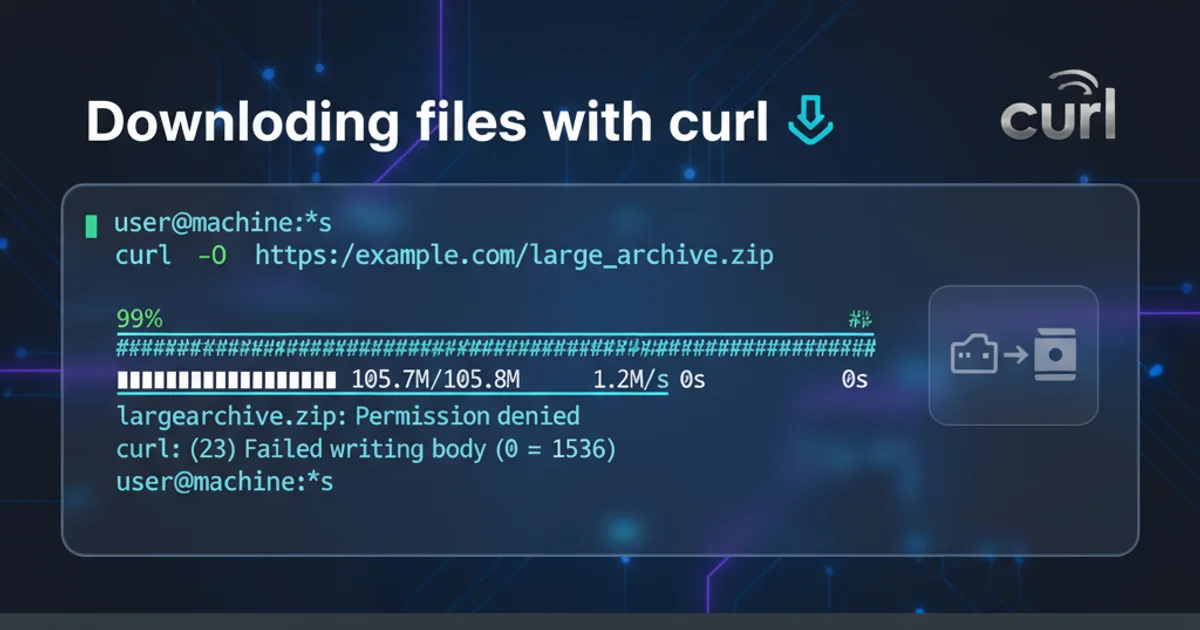Downloading files with curl
Categories:
Mastering File Downloads with cURL

Learn how to efficiently download files from the command line using cURL, covering basic usage, advanced options, and common scenarios.
cURL is a powerful command-line tool and library for transferring data with URLs. It supports a wide range of protocols, including HTTP, HTTPS, FTP, FTPS, SCP, SFTP, TFTP, DICT, TELNET, LDAP, LDAPS, FILE, POP3, POP3S, IMAP, IMAPS, SMTP, SMTPS, RTMP and RTSP. This article will focus on its capabilities for downloading files, a common task for developers and system administrators alike, especially in Linux and Ubuntu environments.
Basic File Download
The most straightforward way to download a file with cURL is to provide the URL of the file. By default, cURL will output the content of the file to standard output (your terminal). To save the file to a local file, you need to use specific options.
curl https://example.com/path/to/your/file.zip
Downloading a file and outputting to standard output.
To save the file to a local file, you can use the -o (output) or -O (remote file name) options. The -o option allows you to specify the local filename, while -O saves the file with its original name from the remote server.
# Save with a specified local filename
curl -o local_filename.zip https://example.com/path/to/your/file.zip
# Save with the remote filename
curl -O https://example.com/path/to/your/file.zip
Using -o and -O to save downloaded files.
-O, cURL will attempt to infer the filename from the URL. If the URL doesn't contain a clear filename, it might default to a generic name or fail. Always verify the downloaded file's name and content.Resuming Interrupted Downloads
One of cURL's most useful features is its ability to resume interrupted downloads. This is particularly helpful for large files or unreliable network connections. The -C - option tells cURL to automatically pick up where it left off.
curl -C - -O https://example.com/path/to/large_file.iso
Resuming an interrupted download using -C -.
When you run this command, cURL checks for an existing file with the same name. If found, it determines the size of the local file and sends a Range header to the server to request only the missing part of the file. This process is illustrated in the following sequence diagram.
sequenceDiagram
participant User
participant Client as cURL
participant Server
User->>Client: curl -C - -O URL
Client->>Client: Check for existing local file
alt Local file exists
Client->>Client: Get local file size (N bytes)
Client->>Server: GET /file HTTP/1.1\nRange: bytes=N-
Server-->>Client: HTTP/1.1 206 Partial Content\nContent-Range: bytes N-M/Total\n[Remaining file data]
Client->>Client: Append data to local file
else No local file
Client->>Server: GET /file HTTP/1.1
Server-->>Client: HTTP/1.1 200 OK\n[Full file data]
Client->>Client: Save full file
end
Client->>User: Download completeSequence diagram for resuming a cURL download.
Advanced Download Options
cURL offers many advanced options for more complex download scenarios. Here are a few commonly used ones:
man curl) for the most comprehensive and up-to-date information on all available options.Download with Progress Bar
To see a progress bar during download, which is very helpful for large files, use the # option with -# or --progress-bar.
curl -# -O https://example.com/path/to/large_file.zip
Follow Redirects
Many URLs redirect to another location. By default, cURL does not follow these redirects. Use the -L or --location option to enable this.
curl -L -O https://shorturl.at/abcde
Authentication
For files protected by HTTP basic authentication, use the -u or --user option.
curl -u "username:password" -O https://secure.example.com/private_file.pdf
Limit Download Speed
To prevent cURL from consuming all your bandwidth, you can limit the download speed using --limit-rate.
curl --limit-rate 100K -O https://example.com/path/to/large_file.zip